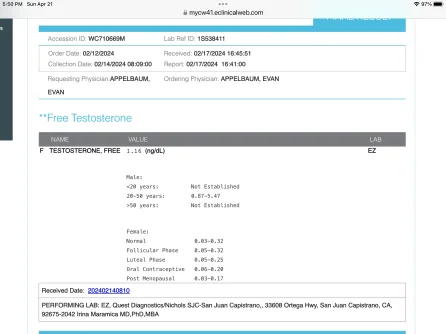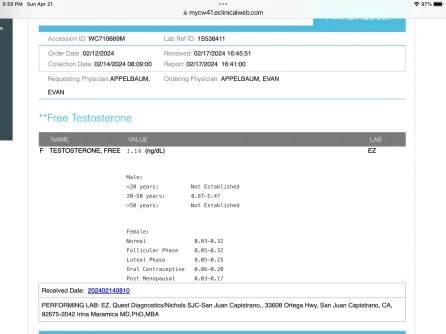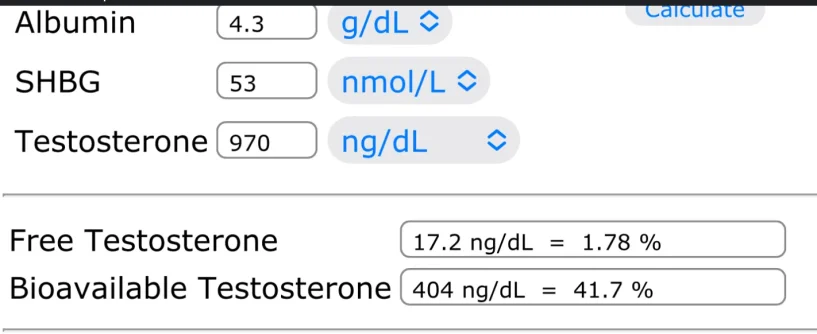madman
Super Moderator
INTRODUCTION AND OBJECTIVE
Measurement of free testosterone (FT) levels can be an important step in the evaluation of men with suspected testosterone deficiency. While it is well known that FT levels decline with age, its clinical utility is limited due to the lack of data on age specific reference ranges. This study aimed to provide age specific reference ranges for FT to assist in the evaluation of men with suspected testosterone deficiency.
METHODS
The 2013-2016 National Health and Nutrition Examination Survey was used to collect data on a nationally representative sample of men in the United States. Men were included in the analysis if they were 20 years old and had total testosterone labs available that were drawn in the morning (between 6 and 10 a.m.). Men were excluded from the study if they had a BMI>30, serum creatinine>1.5, AST or ALT>1.5 times the upper limit of normal, history of diabetes mellitus, testicular cancer, thyroid disease, or were on hormonal medications. FT levels were calculated using total testosterone, sex hormone binding globulin levels and albumin. Age specific ranges were separated into 10-year intervals, with exception of the final interval being all men 80 years old.
RESULTS
1,147 men were included in our final cohort. For each age category, we observed large differences in individual FT levels (Table 1). The highest levels of FT were observed in the youngest category (mean 114.3 pg/mL) and declined on average 12.7% each decade to a mean of 45.8 pg/mL in men 80 years old. The largest decline in average FT was observed from 20s to 30s with an average decline of 16.9% (Figure 1).
CONCLUSIONS
To our knowledge, this is the first study to evaluate age specific calculated FT ranges in adult men. There is a consistent decline in FT in adult men with peak FT concentrations in their 20s. The large range of FT levels within each category indicates the need for a prospective study to identify factors that contribute to declining FT levels and to aid in the clinical diagnosis of testosterone deficiency.
Measurement of free testosterone (FT) levels can be an important step in the evaluation of men with suspected testosterone deficiency. While it is well known that FT levels decline with age, its clinical utility is limited due to the lack of data on age specific reference ranges. This study aimed to provide age specific reference ranges for FT to assist in the evaluation of men with suspected testosterone deficiency.
METHODS
The 2013-2016 National Health and Nutrition Examination Survey was used to collect data on a nationally representative sample of men in the United States. Men were included in the analysis if they were 20 years old and had total testosterone labs available that were drawn in the morning (between 6 and 10 a.m.). Men were excluded from the study if they had a BMI>30, serum creatinine>1.5, AST or ALT>1.5 times the upper limit of normal, history of diabetes mellitus, testicular cancer, thyroid disease, or were on hormonal medications. FT levels were calculated using total testosterone, sex hormone binding globulin levels and albumin. Age specific ranges were separated into 10-year intervals, with exception of the final interval being all men 80 years old.
RESULTS
1,147 men were included in our final cohort. For each age category, we observed large differences in individual FT levels (Table 1). The highest levels of FT were observed in the youngest category (mean 114.3 pg/mL) and declined on average 12.7% each decade to a mean of 45.8 pg/mL in men 80 years old. The largest decline in average FT was observed from 20s to 30s with an average decline of 16.9% (Figure 1).
CONCLUSIONS
To our knowledge, this is the first study to evaluate age specific calculated FT ranges in adult men. There is a consistent decline in FT in adult men with peak FT concentrations in their 20s. The large range of FT levels within each category indicates the need for a prospective study to identify factors that contribute to declining FT levels and to aid in the clinical diagnosis of testosterone deficiency.

















